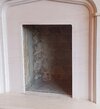Hi folks,
I've recently removed a gas fire with the plans to put in its place a log burner.
I want to tile the surrounding internal space but in order to do so presumably need to render the internal space first? I understand, from other forums, plasterboard, whether heat resistant or not, isn't an ideal solution for the job. Is render the best way to go? Can this then be tiled on top of? What is the best procedure?
Picture attached to show space.
Thanks
I've recently removed a gas fire with the plans to put in its place a log burner.
I want to tile the surrounding internal space but in order to do so presumably need to render the internal space first? I understand, from other forums, plasterboard, whether heat resistant or not, isn't an ideal solution for the job. Is render the best way to go? Can this then be tiled on top of? What is the best procedure?
Picture attached to show space.
Thanks


